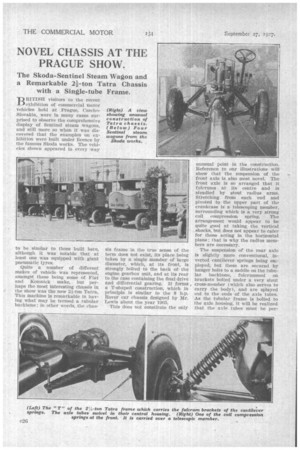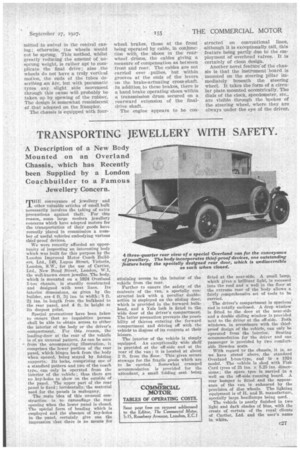NOVEL CHASSIS AT THE PRAGUE SHOW.
Page 48

Page 49

If you've noticed an error in this article please click here to report it so we can fix it.
The Skoda-Sentinel Steam Wagon and a Remarkable 2i-ton Tatra Chassis with a Single-tube Frame.
BRITISH visitors to the recent exhibition of commercial motor vehicles held at Prague, CzechoSlovakia, were in many cases surprised to observe the comprehensive display of Sentinel steam wagons, and still more so when it was discovered that the examples on exhibition were built under licence by the famous Skoda works. The vehicles shown appeared in every way
to be similar to those built here, although it was notable that at least one was equipped with giant pneumatic tyres.
Quite a number of different makes of vehicle was represented, amongst these being some of Fiat and Komnick make, but perhaps the most interesting chassis in the show was the new 21-ton Tatra. This machine is remarkable in having what may be termed a tubular backbone; in other words, the chas
sis frame in the true sense of the term does not exist, its place being taken by a single member of large diameter, which, at its front, is strongly bolted to the back of the engine gearbox unit, and at its rear to the case containing the final drive and differential gearing. It forms a T-shaped construction, which in principle is similar to the 8
Rover. car chassis designed by Mr. Lewis about the year 1905.
This does not constitute the only unusual point in the construction. Reference to our illustrations will show that the suspension of the front axle is also most novel. The front axle is so arranged that it fulcrums at its centre and is steadied by stout radius arms. Stretching from each end and pivoted to the upper part of the crankcase is a telescoping member, surrounding which is a very strong coil compression spring. The arrangement would appear to be quite good at taking, the vertical shocks, but does not appear to cater for those acting in the horizontal plane ; that is why the radius members are necesSary.
The suspension of the rear axle is slightly more conventional, inverted cantileversprings being employed, but these are secured by hanger bolts to a saddle on the tubular backbone, fillet-aimed on brackets bolted under a very stout a cross-member (which also serves to carry the body), and are splayed out to the ends of the axle tubes. As the tubular frame is bolted to the axle housing, it will be realized that the axle tubes must be per
mitted to swivel in the central casing; otherwise, the wheels would not he sprung. This method, whilst greatly reducing the amount of unsprung weight, is rather apt to complicate the final drive; also the wheels do not have a truly vertical motion, the ends ot the tubes describing an arc, but •with pneumatic tyres any slight side movement through this cause will probably be taken up by spewing of the rubber. The design is somewhat reminiscent of that adopted on the Rumpler.
The chassis is equipped with four
wheel brakes, those at the front being operated by cable, in conjunction with, the shoes in the rearwheel drums, the cables giving a measure of compensation as between front and rear: The cables are not carried over piffles, but within grooves at the ends of the levers on the brake-actuatingcross-shaft. in addition to these brakes, there is a hand brake operating shoes within a transmission drum secured on a _ rearward extension of the finaldrive shaft.
The engine appears to be con
structed on conventional lines, -although it is exceptionally tall, this feature being partly due to the employment of overhead valves. It is certainly of clean .design. '
Another novel featureof the chassis is that the instrument board is mounted on the steering pillar immediately beneath the steering wheel. It takes the form of a circular plate mounted eccentrically. The dials of the clock, speedometer, etc., are visible through the 'spokes of the steering wheel, where they are always under the eye of the driver.












































































































